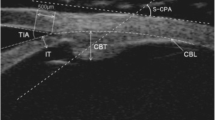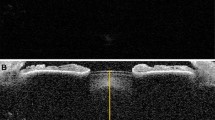Abstract
Background. Our objective was to develop a three-dimensional high-resolution ultrasonic imaging technique to be utilized for in-vivo characterization of the ciliary body and the posterior iris. The benefit of this imaging in enhancing the quantification of the configurational changes in the ciliary body during accommodation is demonstrated.
Methods. Sequential ultrasound biomicroscopic images of the ciliary body region were obtained with a computer-controlled scanning device designed for use with a standard ultrasound biomicroscope for 3D imaging. Custom-made software allows online data collection, data analysis and 3D reconstruction in conjunction with commercially available VoxelView software.
Results. The three-dimensional presentation allows a close approximation of the ciliary muscle inside the ciliary body in vivo. We are able to distinguish and to analyze the changes in the muscle contour in different accommodation states. During accommodation a shift in the ciliary muscle center of gravity in a range of 0.04–0.26 mm (mean 0.13±0.06 mm) in the direction of the lens equator, with an interindividual variation and a small decrease with age, was observed.
Conclusions. High-resolution ultrasound is a well established technique for in-vivo investigation of the anterior segment. Three-dimensional ultrasound biomicroscopy allows an assessment of the individual ciliary muscle activity in consideration of the ciliary processes. In combination with a contour analysis tool we improved the muscle contour determination during different accommodation states. The investigation showed an activity of the ciliary muscle in young volunteers as well as those of presbyopic age.
Similar content being viewed by others
Author information
Authors and Affiliations
Additional information
Electronic Publication
Rights and permissions
About this article
Cite this article
Stachs, O., Martin, H., Kirchhoff, A. et al. Monitoring accommodative ciliary muscle function using three-dimensional ultrasound. Graefe's Arch Clin Exp Ophthalmol 240, 906–912 (2002). https://doi.org/10.1007/s00417-002-0551-2
Received:
Revised:
Accepted:
Issue Date:
DOI: https://doi.org/10.1007/s00417-002-0551-2




